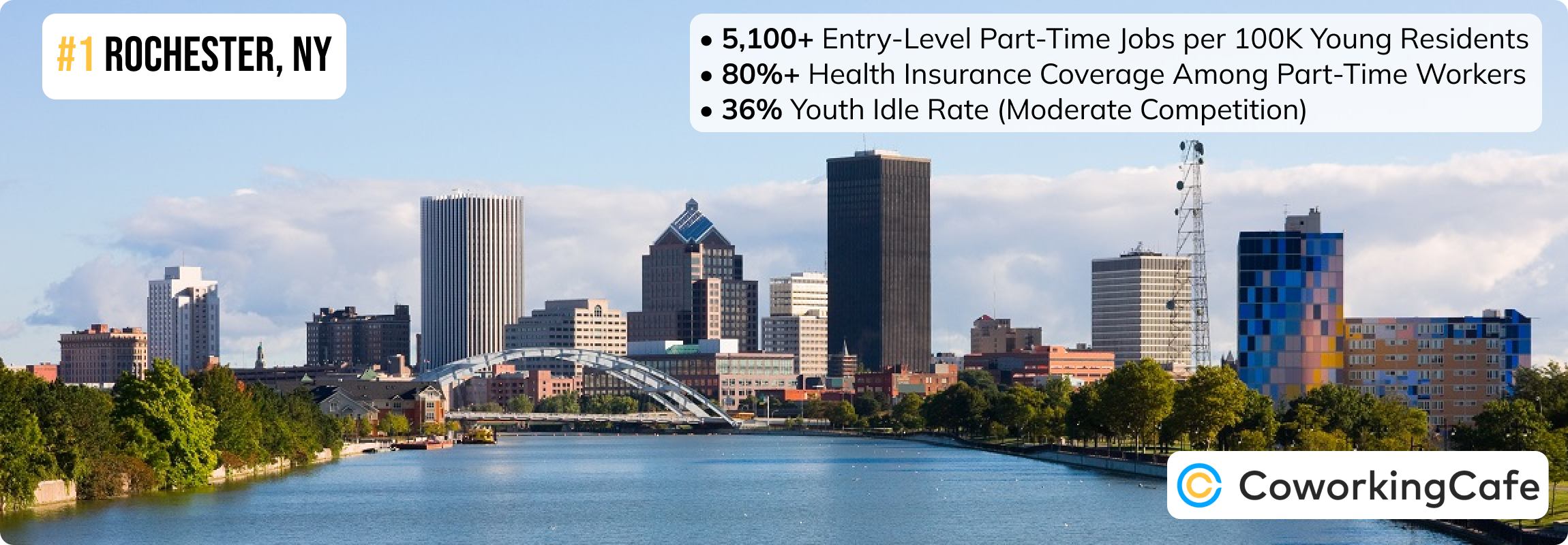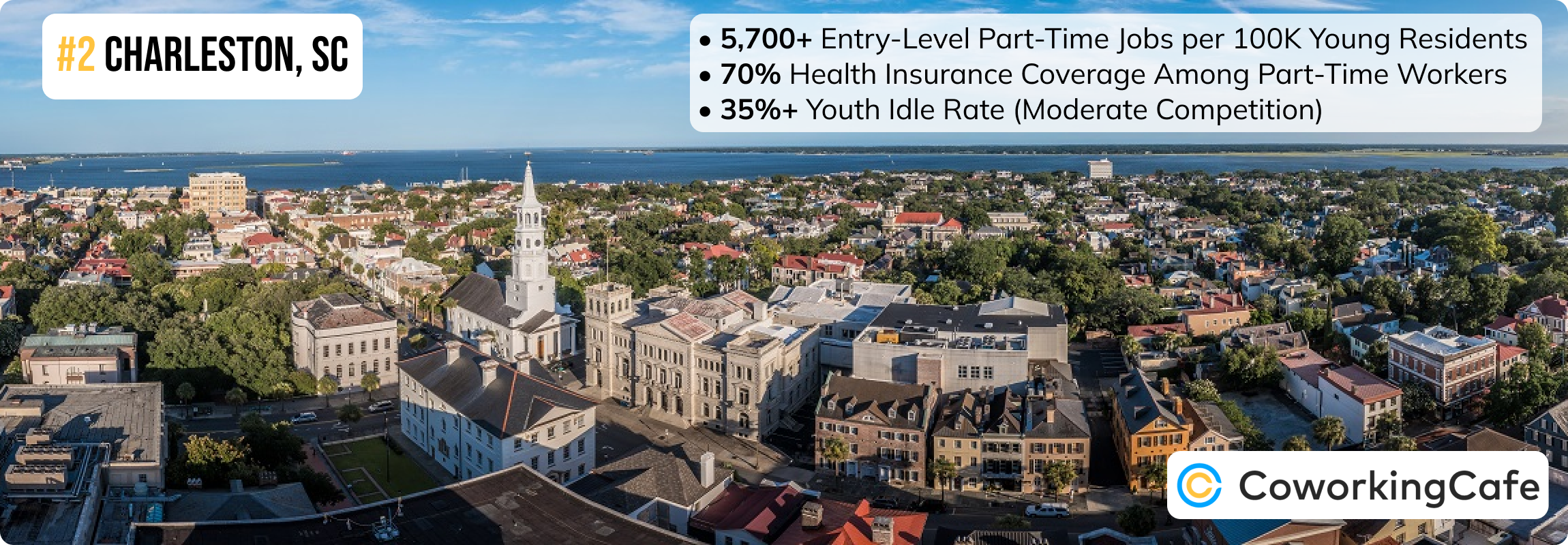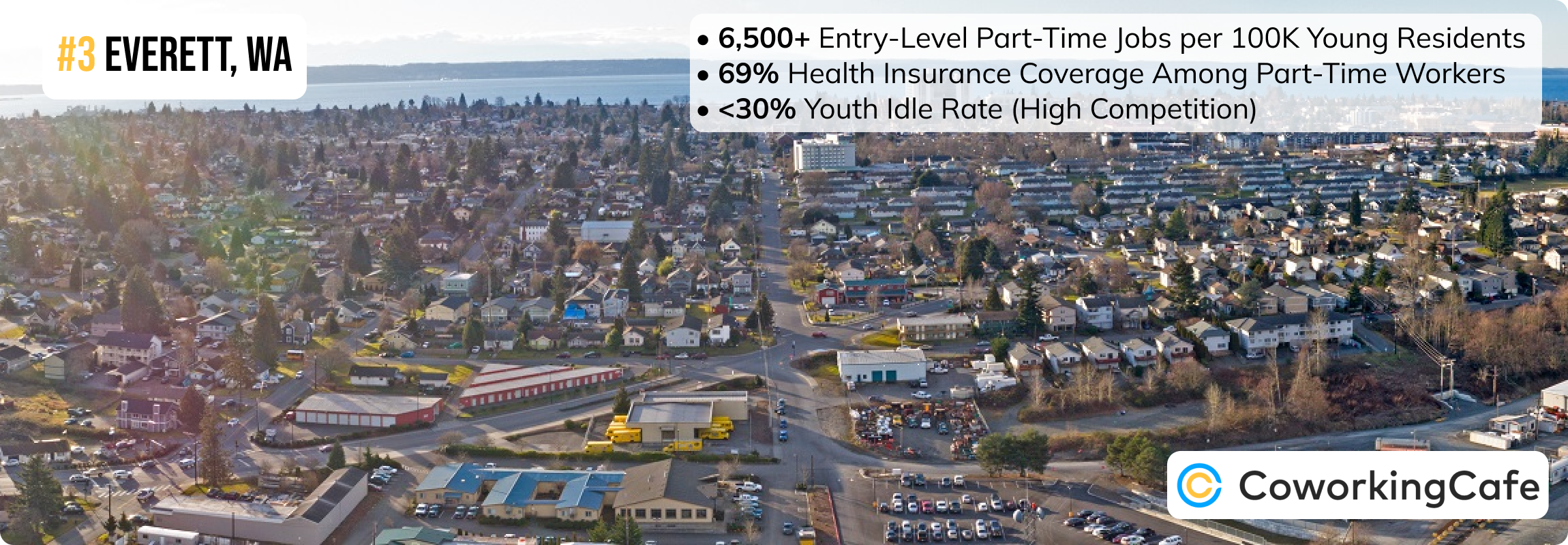Key Takeaways:
- The Northeastern U.S. emerged as the region with the highest-scoring cities for summer part-time work, followed by the Midwest and the West Coast.
- Rochester, NY was the best city overall for summer work for young adults, thanks to a wealth of job openings and high health insurance coverage among part-timers.
- In second place, Charleston, SC was the best place for young job-seekers on the South-Atlantic coastline, scoring high in most metrics.
- Everett, WA had the most part-time job openings per capita, landing on the podium despite strong competition among young adults compared to other top cities.
- Beyond job availability, most top-ranked cities also excelled in supporting part-time workers with health insurance as an employee benefit.
Gen Z may be one of the most diverse generation to date, but their aspirations and expectations at work are unanimous: meaningful work, inclusive environment and good work/life balance. For many, employers showing support by including health insurance in the benefits package also outweighs the importance of the wage itself. And, although many are still pursuing education, more than half of Gen Zers already have a side hustle. It’s safe to say, then, that the newest workforce participants are keen to start working, and they don’t mind working multiple shifts. They do, however, have a long checklist when browsing want ads.
So, with the summer break approaching, CoworkingCafe studied the job markets of more than 300 U.S. cities to identify the best job-hunting terrains for young adults seeking to gain experience working part-time. Beyond the obvious job availability, we also assessed metrics that gauge the prevalence of part-time work arrangements among the young workforce, the level of competition for open positions, health insurance coverage rates among part-time employees, as well as the viability of affordable commutes. Jump to the methodology section for more details.
Mid-Sized Northeastern Cities in Lead for Summer Part-Time Work
While the top cities for finding entry-level, part-time jobs were spread across the nation, the Northeast stood out with four high-scoring cities at the very top of the list, spoiling young applicants for choice with a smorgasbord of job openings. Not to be outdone, the Midwest was represented by two top-10 contenders and another two cities in the top 15 along similar considerations.
Meanwhile, although mostly further down the list, the West Coast took five positions in the top 15 with secondary metrics also taking center stage. Lastly, the South-Atlantic region was also prominent, snatching one place on the podium, as well as another top-10 position.
Otherwise, in a state-level breakdown, California was well-represented in the top 15 with three entries. It was followed by New York, Washington, Massachusetts and Illinois with two high-scorers each.
1. Rochester, NY – Total Points: 66.8
 Rochester, NY emerged as the premier hub for summer part-time employment largely due to a wealth of job opportunities and robust support for part-time workers. Specifically, the local job market offered more than 5,100 open positions per 100,000 residents aged 16 to 24 of at the time of the analysis — the third-highest job availability on our list and about five times the national average. Furthermore, 80% of part-time roles in Rochester offered health insurance, representing the fifth-highest share among the top 15 cities for summer part-time jobs.
Rochester, NY emerged as the premier hub for summer part-time employment largely due to a wealth of job opportunities and robust support for part-time workers. Specifically, the local job market offered more than 5,100 open positions per 100,000 residents aged 16 to 24 of at the time of the analysis — the third-highest job availability on our list and about five times the national average. Furthermore, 80% of part-time roles in Rochester offered health insurance, representing the fifth-highest share among the top 15 cities for summer part-time jobs.
Additionally, with 26% more young part-time than full-time workers, Rochester ranked high with a significant emphasis on part-time employment opportunities for young people. This also left more than one-third of the young population (36%) idle, suggesting relatively low competition for youth-focused jobs. Plus, the 6% public transportation use was also well above the average, meaning affordable commutes are a viable option for many young workers in Rochester.
2. Charleston, SC – Total Points: 65.6
 Charleston, SC secured the second spot by distinguishing itself as a beacon for young job-seekers along the South-Atlantic coast. Here, the city reported the second-highest number of part-time job openings per capita at just more than 5,700 per 100,000 residents aged 16 to 24. Likewise, health insurance coverage for part-time workers stood at 70%, which was slightly below that of Rochester, but still substantial enough to attract those valuing job security and benefits.
Charleston, SC secured the second spot by distinguishing itself as a beacon for young job-seekers along the South-Atlantic coast. Here, the city reported the second-highest number of part-time job openings per capita at just more than 5,700 per 100,000 residents aged 16 to 24. Likewise, health insurance coverage for part-time workers stood at 70%, which was slightly below that of Rochester, but still substantial enough to attract those valuing job security and benefits.
At the same time, the slightly lower youth idle rate of 35% — coupled with a competitive, 25% prevalence of part-time employment — also suggests a dynamic environment for ambitious young workers.
3. Everett, WA – Total Points: 62.8
 Everett, WA snatched a podium placement with the absolute highest number of job openings per capita among our surveyed cities, counting more than 6,500 opportunities per 100,000 young adults at the time of reporting. Yet, despite this momentary abundance, Everett presents a slightly more challenging landscape for job-seekers throughout the year with only 9% more part-time workers than full-time employees in the city's workforce.
Everett, WA snatched a podium placement with the absolute highest number of job openings per capita among our surveyed cities, counting more than 6,500 opportunities per 100,000 young adults at the time of reporting. Yet, despite this momentary abundance, Everett presents a slightly more challenging landscape for job-seekers throughout the year with only 9% more part-time workers than full-time employees in the city's workforce.
Otherwise, the 69% health insurance coverage among part-timers aligns with Everett’s commitment to supporting young workers, while its below-average competition outlined by the 29% youth idle rate is also good news for ambitious job-seekers.
4. Hartford, CT – Total Points: 56.5
Hartford, CT combines excellent support metrics with a more moderate part-time job availability than some of the top contenders. That said, the city nevertheless offered nearly 3,000 job openings per 100,000 young adults, which was still almost three times the national average. This, coupled with a 74% health insurance coverage rate among part-time workers, positions Hartford as a great place for summer jobs for those who prioritize well-being alongside work.
The city also featured a substantial 31% part-time work prevalence. This was further supported by the second-most-used public transportation system, thereby facilitating accessible workplace environments.
5. Syracuse, NY – Total Points: 55.2
Syracuse, NY ranked fifth with a notable emphasis on part-time employment opportunities, highlighted by almost 2,300 entry-level want ads and a whopping 39% part-time work prevalence. As such, this marked the strongest emphasis on part-time jobs in the local work culture among our top-ranking cities.
Syracuse also excelled in health coverage with 77% of part-time jobs offering insurance. And, the fifth-highest youth idle rate of 39% also suggests relatively low competition for new entrants eager to start working.
6. Springfield, MA – Total Points: 54.9
Springfield, MA stood out among the top cities for its 82% health insurance coverage rate — the third-highest on the list. While the city’s job availability lagged behind the top five cities, nearly 2,000 openings per 100,000 young adults is still almost double the national average and reveals a great environment for career-starters seeking a part-time job for the summer.
Furthermore, only one in two young adults participated in the local work force, which improves the odds for those actively seeking. On the flip side, Springfield performed below the average when it came to the general prevalence of part-time employment with just 17% more young workers holding part-time jobs. This indicates a generally less-flexible job market, which could potentially restrict entry-level opportunities.
7. St. Louis, MO – Total Points: 53.9
St. Louis, MO showcased a balanced offer with more than 4,000 part-time job openings — the fourth-highest among top-ranking cities — and a 67% health insurance coverage rate to position itself as a nurturing ground for young professionals looking to gain meaningful work experience.
Notably, the city hosts a moderately flexibility-focused work culture with 23% more part-time workers than full-time employees (on par with the national trend). At the same time, St. Louis’ public transportation usage rate was also the sixth-highest on the list at more than 6%, supporting affordable commuting options for those without personal transportation.
8. Cleveland, OH – Total Points: 53.1
Cleveland, OH provides a dynamic environment for young job-seekers with a 26% youth part-time work prevalence, which closely mirrored the national average. This balanced scenario — supported by a 73% rate of health insurance coverage for part-time workers — underscored Cleveland’s position as a supportive place for those beginning their career journey.
Moreover, with almost 3,000 job openings per 100,000 young adults, Cleveland offered a substantial number of opportunities. That was complemented by enhanced accessibility to these jobs with a slightly above-average, almost 8% public transportation usage rate — the third-highest among the top cities for summer part-time work.
9. Richmond, VA – Total Points: 52.5
Back on the East Coast, Richmond, VA was prominent with its strategic approach to part-time employment by featuring nearly 3,900 job openings per 100,000 young adults, as well as a strong, 31% part-time work prevalence among young workers, to earn the city fourth place in this metric in a tie with Hartford.
Health insurance coverage for part-time positions in Richmond stood at 70%, making it an appealing locale for those valuing both work opportunities and benefits. What’s more, Richmond’s 4.3% public transit use also suggests manageable commuting routes, making affordable commutes a viable option for summer part-timers.
10. Burbank, CA – Total Points: 51.7
With around 1,350 job openings per 100,000 young adults, the opportunities in Burbank, CA were more selective, yet highly beneficial given the emphasis on quality employment conditions. Plus, the high rate of idle population among young residents keeps competition for these jobs in check as 46% of the eligible youth didn’t participate in the workforce.
The city also distinguished itself with the highest health insurance coverage among the top cities at 82%, paired with a healthy 26% part-time work prevalence among young adults. Even so, Burbank’s lower public transit usage rate at under 2% suggests that, while jobs are lucrative, summer part-timers will likely need to rely on a car to get to work, depending on the location.
11. Torrance, CA & Springfield, IL – Total Points: 51.3 (Tie)
Torrance, CA, excelled with a 35% gap in favor of part-time positions when compared to full-time work among young adults. That was the third-highest prevalence on the list, which indicates a welcoming environment for those seeking flexible work schedules. The youth idle rate was also the fourth-highest at a whopping 42%, suggesting low competition for jobs. Additionally, 77% of part-time jobs offered health insurance, thereby supporting Torrance’s commitment to quality part-time employment. However, public transportation usage here remained low at just above 1%, suggesting that commuting might require reliance on personal transportation.
Next, while Springfield, IL earned the same overall score, it presented different strengths when looking at the individual metrics. For instance, with almost 3,000 part-time job openings per 100,000 young adults (twice as many as Torrance) the city offers a balanced job market with a solid health insurance coverage rate of 70% for part-time workers. And, although the less than 2% public transportation usage suggests potential challenges in commuting, the moderate competition with a 37% youth idle rate — coupled with the supportive job environment — makes Springfield an attractive job-hunting terrain for those prioritizing flexibility and job benefits.
12. Boston, MA – Total Points: 50.1
Boston, MA’s position in the top 15 was bolstered by the second-highest, 37% part-time work prevalence compared to full-time employment among young adults. This metric indicates a strong preference for flexible job arrangements among local employers. The city also had the highest public transportation usage rate among the top cities, by far, at almost 26%.
Furthermore, 82% of part-time jobs in Boston came with health insurance benefits, snatching another second place in the breakdown and further highlighting the city’s focus on providing supportive work environments for its young population.
13. Peoria, IL – Total Points: 50
Peoria, IL offered a solid platform for part-time job-seekers with north of 3,000 openings per 100,000 young adults and a 72% health insurance coverage rate among part-timers.
Although the city had a moderate prevalence of part-time work among young adults (23% more than the number of full-time employees, which was on par with the national average), it still maintains a competitive market for those entering the workforce. However, Peoria’s public transportation usage at just over 1% shows a greater dependence on personal vehicles for commuting to work.
14. Irvine, CA – Total Points: 49.9
Despite hosting fewer job openings (just under 550 open part-time positions per 100,000 young adults), Irvine, CA showcased an excellent 80% health insurance coverage — the fourth-highest on our list — ensuring high-quality conditions for part-time workers. The city also had a 28% prevalence of part-time jobs among young workers, which was moderately higher than the national average.
Even so, the low public transportation usage at less than 1% points toward potential challenges in accessing these workplaces via public transit. But, in spite of fewer job openings, the city’s high rate of health insurance coverage and low competition for open positions (52% of the eligible youth don’t pursue a career) make Irvine an attractive place for finding part-time work.
15. Bellevue, WA – Total Points: 49.8
Lastly, Bellevue, WA featured more than 1,800 part-time job openings per 100,000 young adults and a 74% health insurance coverage rate, presenting a supportive backdrop for career-starters.
With a considerable 30% part-time work prevalence over the number of full-time positions among young adults, Bellevue employers clearly prioritize part-time employment, demonstrating ample flexibility for young job-seekers. Plus, the city’s public transportation usage rate at just over 7% is also more than double the national average, assisting in connecting young workers to their places of employment more effectively than many other cities.
Expert insights

Department of Leadership and Professional Studies
Barry University
Health care insurance is crucial and that is why organizations such as several multinational food and beverage chains use it for their part-time employees.
Health care has grown to be very expensive, and many things are not covered by insurance. However, what is covered by insurance is essential to young part-time workers' well-being.
How can cities and employers better cater to Gen Z workers' preferences for meaningful work, work/life balance, and health benefits to attract and retain them in part-time positions?
There are several ways to categorize part-time workers, and many of them are transient. Gen Z workers need to be involved in decision-making, have a chance to be innovative, and creative.
The key is to give them a positive line on their résumé and involve them more so that their work can be a segue into their future career.
Read more...
Part-time work is essential for college-bound students or those attending trade schools.
The key is making the difference between part-time work and full-time work equivalent. The only difference should be the short notice and temporary position transition. This, however, needs to be carefully constructed, well-communicated, and containing no surprises along the way.
Do you have any specific recommendations for policymakers, city planners, or employers to improve opportunities and conditions for young adults seeking part-time summer employment?
A young adult is very important for society. These individuals needed to be nurtured, trained, and cared for in a way that paves the way for their future careers.
Train them well, teach them how to respect authority figures, and give them the wherewithal to add value to society as they grow up.

Brad D. Smith Schools of Business, Lewis College of Business
Marshall University
For young part-time job-seekers, health insurance coverage is a significant consideration when applying for employment. If compensation and benefits are not clearly presented, job-seekers can quickly move on to the next potential employer.
How can cities and employers better cater to Gen Z workers' preferences for meaningful work, work/life balance, and health benefits to attract and retain them in part-time positions?
With Gen Z, meaningful work can be illustrated by clearly expressing how a position fits within the overall organization’s operations and how the position impacts customers.
Also, an organization’s expectations of time commitment and potential career advancement needs to be clearly detailed as this influences job-seekers’ decisions concerning their commitment to work/life balance. Compensation also must be detailed especially concerning health insurance, growth opportunities, and experiences. These items have been identified as significant to job-seekers.
Read more...
In the future, part-time work may be more prevalent. Some positions require more technical expertise and specialized skill sets. As such, it is easier to employ a part-time worker to complete specific tasks for a team. Moreover, organizations can reduce costs associated with physical spaces when hiring part-time workers.
This means that job-seekers must have diverse skill sets to compete for these positions and must present their value to organizations in terms of their skill sets, education, experience, and accomplishments. Thus, the standard one-page résumé may look more like an executive summary with a portfolio that details job-seekers’ skill sets.
Do you have any specific recommendations for policymakers, city planners, or employers to improve opportunities and conditions for young adults seeking part-time summer employment?
For those looking to employ part-time workers during the summer, plan early. February is a great time to advertise summer work opportunities to young adults.
In addition to providing a realistic job-preview, an advertisement should clearly detail the compensation and benefits of the position. This helps attract applicants that more closely align with that position.
Moreover, where the advertisement is seen is also important to attracting the right applications. If an organization is looking at recruiting younger employees, efforts should be made to go beyond a digital application. That is, recruit from high school, colleges, community centers, and places where young people gather.
Methodology
For this report, CoworkingCafe compared 331 U.S. cities with at least 100,000 residents that had data for all metrics analyzed.
We used a proprietary scoring system to synchronize the key metrics analyzed and then weighted them to reflect their significance in determining the top cities for summer part-time work for young adults.
The total score was calculated using the following data points and weighting:
1. Youth Part-Time Job Availability (LinkedIn – April 24, 2024)– 35% of total score
Number of part-time job openings (on-site and hybrid, no college degree required) per 100,000 residents aged 16 to 24. (Higher score means a wider pool of job opportunities before the summer season).
2. Youth Idle Rate (Census 5-year estimates – 2022) – 25% of total score
Share of young idle population aged 16 to 24 who did not participate in the labor force in the past 12 months. (Higher score means lower competition for jobs).
3. Youth Part-Time Work Prevalence (Census 5-year estimates – 2022) – 20% of total score
Difference between the number of residents aged 16 to 24 working full-time and those working less than full-time. (Higher score means a greater emphasis on flexible work arrangements in the local labor market or more opportunities for part-time employment throughout the year).
4. Part-Time Health Coverage (Census 5-year estimates – 2022) – 15% of total score
Share of part-time employees with health insurance coverage. (Higher score means a higher likelihood of finding part-time jobs with health insurance as an employee benefit).
5. Public Transit Use (Census 5-year estimates – 2022) – 5% of total score
Share of commuters riding public transportation, excluding taxicabs. (Higher score means lower reliance on a personal vehicle for commuting).
Fair Use & Redistribution
We encourage and freely grant you permission to reuse, host or repost the images in this article. When doing so, we only ask that you kindly attribute the authors by linking to CoworkingCafe.com or this page so that your readers can learn more about this project, the research behind it and its methodology.







